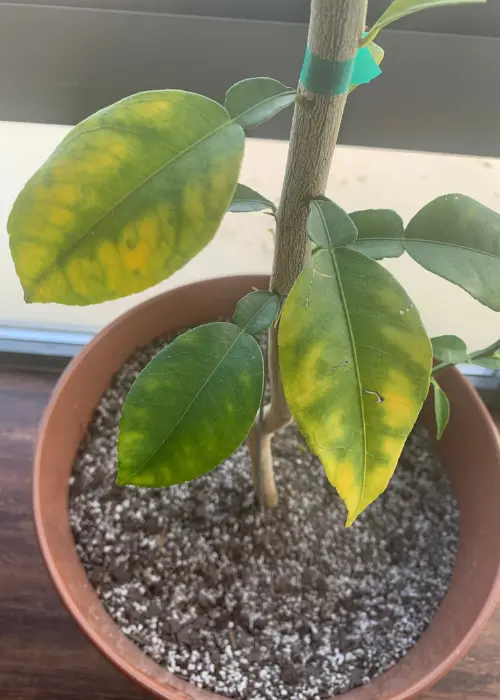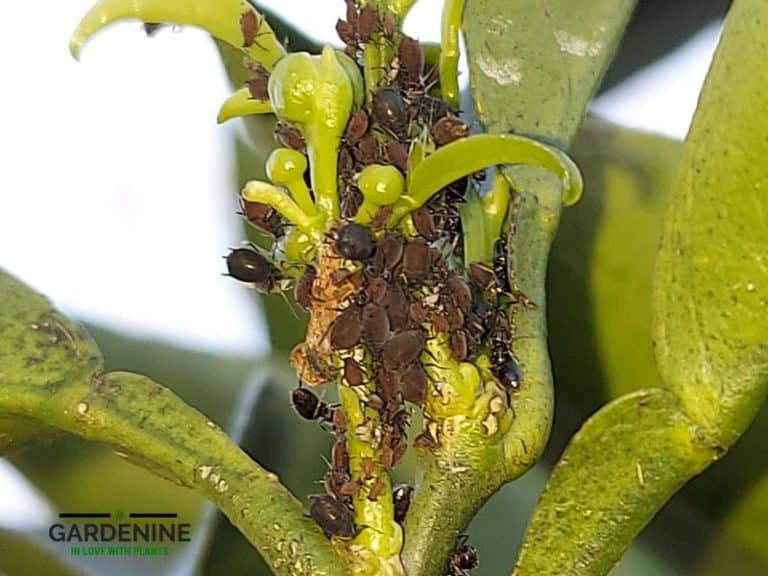What’s Causing Sticky Lemon and Citrus Leaves?
If you plant citrus trees such as lemons, oranges, kumquats, and grapefruit, you’ve at some point noticed defects on the leaves and stems. Discoloration, leaf damage, and sticky substances on citrus trees are common.
These signs point toward a disease or pest attack on the plant that leaves behind a sticky film on the foliage or stems. While this can be confusing, there is an explanation behind it.
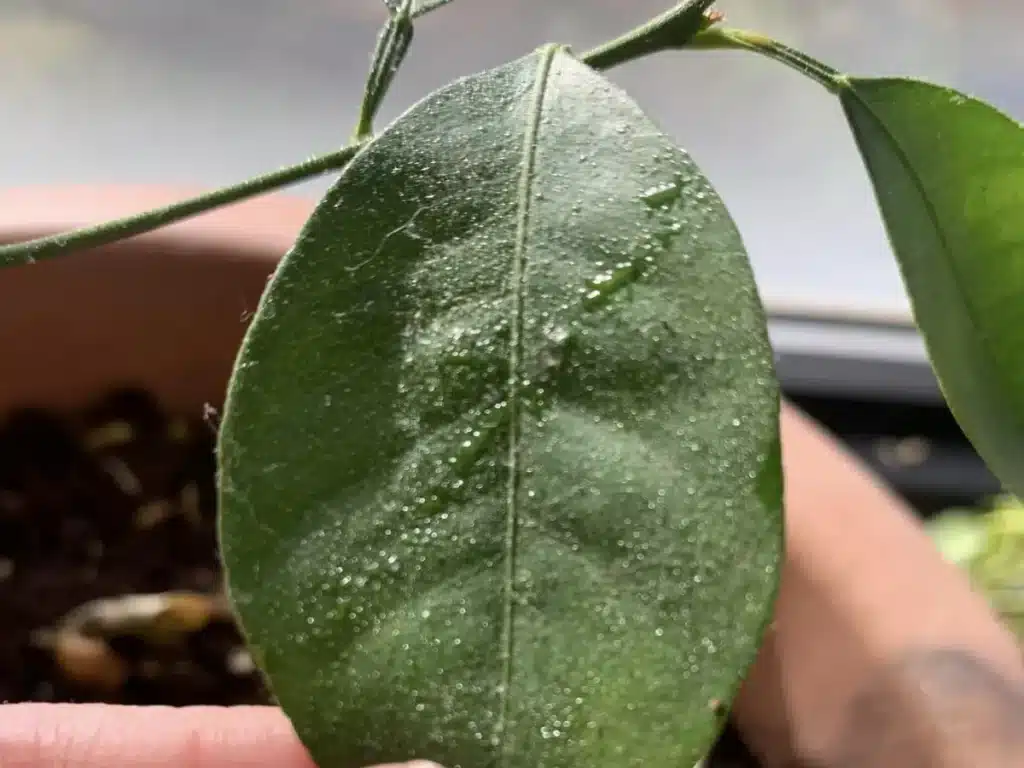
KEY TAKEAWAY
The main culprits are sap-sucking insects that feed on the tree’s fluids. Pests like aphids, scale, mealybugs, and whiteflies pierce the leaves and extract the sap. As they feed, they excrete a sugary substance called honeydew that coats the foliage. This honeydew is what causes stickiness on the affected citrus plants.
The honeydew can become a magnet for many other problems on lemon trees, as you will learn later in this article.
What causes a sticky substance on lemon trees?
In general, sap-sucking insects are the main cause of the sticky residue on lemon and citrus leaves.
These include aphids, scale, mealybugs, and whiteflies. They use their slender, needle-like mouthparts to pierce the foliage and extract the sap from the inner leaf tissues.
Certain insect pests commonly infest citrus trees and can build up significant infestations if left uncontrolled.
They are often first noticed on the undersides of leaves or on young shoots. With heavy populations, they spread across the tree, covering leaves and branches with their presence.
I’ve found that sticky substances on lemon trees can be caused by the following pests:
Scale insects
Scale species like red scale, brown soft scale, and black scale commonly attack citrus trees. They anchor themselves to plant leaves and stems.
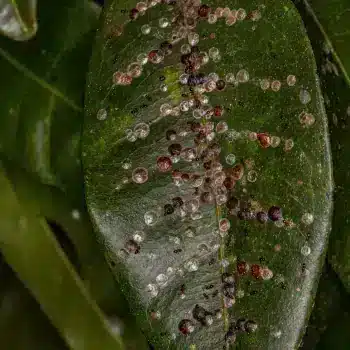
Covered by their protective waxy shells, they insert needle-like mouths to suck out sap. Their armor remains on the tree or fruit even after the insect dies, causing damaged fruits.
Scale insects feed mostly on twigs but also on leaves and fruit while excreting honeydew that accumulates on the leaves, branches, and fruits.
The honeydew is sticky and can be devastating to your lemon tree as it attracts ants and sooty mold.
Controlling scale insects
Using pesticides is one of the best ways to control scales on citrus trees. I use neem oil, and I find it effective in managing scales.
Neem oil contains azadirachtin, a highly effective organic pesticide that protects against scale insects while killing already established ones.
You can make a homemade scale killer solution using neem oil, water, and dish soap.
Mix ½ a gallon of water with 2 tablespoons of neem oil and 1 teaspoon of dish soap. Stir the mixture thoroughly until it’s consistent. Pour the solution into a spray bottle and generously spray the entire citrus tree, focusing on the tops and undersides of the leaves where scale insects often reside.
Note: The soap acts as an emulsifier, ensuring the oil disperses evenly in the water.
Mealybugs
Citrus mealybug is a common pest in citrus groves. You can identify mealybugs by their soft, oval, flattened bodies covered in a white waxy layer that makes them appear like small cottony blobs on leaves and stems.
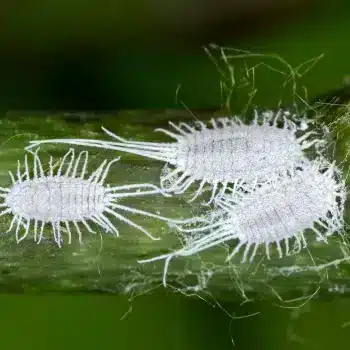
Mealybugs suck sap on the lemon tree leaves and excrete honeydew, which coats the leaves, creating a surface where black sooty mold grows.
The sooty mold leads to not the not-so-appealing appearance of fruits, requiring hard scrubbing to remove them.
If left for long, mealybugs will weaken your citrus trees and even kill them.
Mealybug control
Mealybugs are not easy to control with pesticides because of the sticky substance that makes them water-resistant.
However, they’re susceptible to sprays of horticultural oil and insecticidal soap. Spray thoroughly since their cottony secretions protect their bodies.
We also use systemic pesticides to impair their feeding on sap. My go-to systemics for large-scale mealybug infestations in citrus plants are Imidacloprid and dinotefuran.
You can also dislodge clusters of mealybugs using a high-pressure water spray. Remember, ant control is also important, as ants protect mealybugs.
Removal of loose bark can also reduce the number of mealybugs that cause sticky substances on your citrus trees..
Aphids
Another common pest that makes lemon leaves sticky is aphids.
Aphids are tiny, soft-bodied insects that cluster on young shoots and the undersides of leaves. Ranging from 1-3 mm in length, they can be green, yellow, brown, red, or black depending on the species.
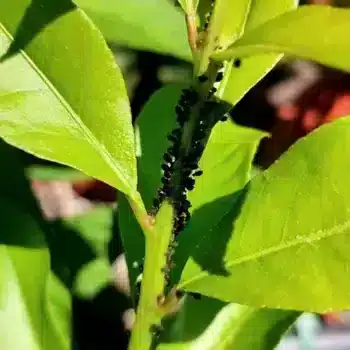
These pests attack plants in large groups, even covering whole leaves and twigs. As they feed on the plant, they secrete a sticky, sugary liquid – honeydew.
To find out if the sticky lemon leaves are caused by aphids, carefully check the tender new growth of citrus trees for clusters of small, colored insects.
Solution
Aphids have many natural predators, so I recommend introducing ladybugs, lacewings, and other beneficial insects to control their populations.
Insecticidal soaps, neem oil, and strong sprays of water dislodge them from foliage, but these only work for small-scale infestations.
For an orchard, apply a systemic insecticide to the soil or tree for longer-term protection.
Although aphids rarely kill a mature tree, the damage they cause with the hideous honeydew sometimes needs control. Avoid using chemical controls.
You can use a natural treatment such as planting flowers near your lemon tree that will attract aphid predators. You can also apply neem oil to the leaves. The oil will help suffocate the aphids.
Learn more on how to control aphids on lemon trees.
Whiteflies
Whiteflies are tiny, moth-like insects about 1-2 mm long with powdery white wings. They often feed on the undersides of leaves. When disturbed, they will briefly flutter their wings before settling back down.
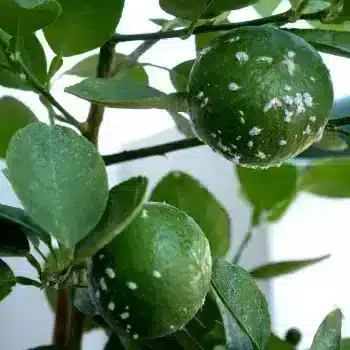
Whiteflies tend to remain stationary while feeding, only moving when brushed off the leaves.
When feeding in large groups, whiteflies can cause citrus leaves to turn yellow and wilt.
Whiteflies damage your lemon tree leaves by sucking the sap of the living tissues from the leaves. They excrete a sugary, sticky liquid (honeydew) that makes the leaves sticky.
Honeydew also attracts ants to your tree and encourages the growth of black sooty mold on the plant.
Solution
Adult whiteflies are difficult to control with contact sprays, but their nymphs are vulnerable. Use systemic insecticides and insect growth regulators to disrupt their life cycle.
In case of a whitefly infestation on your citrus plants, remove the leaves that host high whitefly populations.
I often use sticky traps to control whitefly populations in orchards. Neem oil sprays have also worked well to deter adults from feeding on foliage and stems.
In small citrus orchards and gardens, I often recommend parasitoid wasps and fungi that attack whiteflies, reducing their damage.
How to Remove the Sticky Substance
Honeydew is water-soluble, meaning you can get rid of the sticky substance on your lemon tree leaves by rinsing thoroughly with water. Lukewarm water works best.
Here are two ways of getting rid of the sticky substance on your lemon tree leaves:
- Spraying of horticultural oils in early spring, mid-summer, and late winter will stop the scales from breathing through the leaves. Spraying infested leaves with horticultural oils (e.g., Bonide Horticultural Oil) at the correct time will help control the spreading of the sticky substance.
- Applying Insecticidal soap in early summer and repeating it in mid to late summer also helps remove the sticky substance on your leaves. Neem oil is the best insecticide for lemon tree leaves if the sticky substance persists.
- Wipe or wash off the sticky substance from citrus leaves. Be gentle to avoid damaging the affected plant’s leaves.
I recommend removing the sticky film after eradicating all or major honeydew-producing insects.
Prevention
Once the sticky residue issue is solved, focus on prevention:
- Inspect regularly, especially during new growth and after pruning.
- Apply horticultural oil dormant sprays to suffocate overwintering pests.
- Remove weeds, dead leaves, and debris that shelter pests.
- Use preventive soil drenches and tree injections of systemic insecticides if pests are severe.
- Wash off honeydew and sooty mold to avoid buildup.
- Introduce predatory insects early in the season before pest populations explode.
- Use sticky traps to monitor for whiteflies and other pests.
Do lemon trees drip sap?
Lemon trees do not normally drip sap or have sap running down their trunks and branches. However, a few reasons could cause a lemon tree to seem like it is dripping sap: a wound caused by insect infestation, diseases, or mechanical injuries.
- Slime flux- a bacterium that enters the tree through wounded roots or wounds in the trunks of vulnerable trees, making the sap leak.
- Bacterial Canker- These bacteria enter the tree through wounds caused by weather damage or insects. Bacterial canker will make the tree produce sap that flows out with high pressure through the wounds.
- Water or rain running down the trunk carrying sugars and other substances, making it appear like sap dripping.
- Insect pests are also attracted to tree sap. Tree borers are an example of insects that chew and feed on the inner bark or wood of the tree. They remove the tree’s bark, disrupting the normal flow of nutrients and water. You will notice the presence of borers in your lemon tree plant when you see sap oozing from the small holes in the trunks.
Further reading:
Here are articles that can also help you further with your citrus and lemon trees:
Conclusion
An integrated approach utilizes multiple strategies simultaneously to target all plant pest life stages. Identify which sap feeders are present and causing the sticky leaves. Ideally, eliminate aphids, scale insects, mealybugs, and whiteflies at the onset of their infestation to prevent the sticky honeydew problem.



